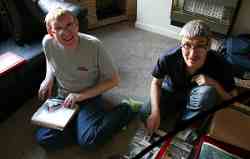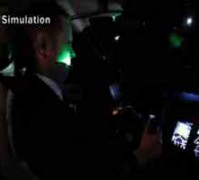
Middle aged brothers afflicted with Leukodystrophy; age backwards

Michael Clark and Matthew Clark suffer from Leukodystrophy and now have the capacity of 10-year-olds. (Photo: Channel4.com)
Middle aged brothers afflicted with Leukodystrophy; age backwards
Michael and Matthew Clark are two Middle aged brothers afflicted with Leukodystrophy.
The Mail Online first reported about the Clark brothers earlier this year.
A few week backs, all the papers were buzzing with headlines ; “Real Benjamin Buttons Brothers: Matthew and Michael Clark Are Aging Backwards”, “Brothers diagnosed with ‘Benjamin Button’ age-reversing disease” and even “The Curious Case of the Clark brothers”.
The last headline is the title of the British documentary, The Curious Case of the Clark Brothers, and the situation is anything but light.
These two grown men are turning back to into children before their parent’s eyes, and, to them, they find the titles offensive.
It’s likely sensationalism and not meant to offend, however, it almost paints this horrible disease they suffer from in a light fashion.
There is nothing light about Leukodystrophy.
What is Leukodystrophy?
Leukodystrophy refers to progressive degeneration of the white matter of the brain. It’s a genetic disorder that affects the central nervous system.
It is usually inherited, although there are some Leukodystrophies that do not appear to be inherited, but rather arise spontaneously.
They are still caused by a mutation in a particular gene, but it just means that the mutation was not inherited.
If it not inherited, the birth of one child with the disease does not necessarily increase the likelihood of a second child having the disease.
Not being a scientist, it does seem that being that both children developed the disease later in life, it seems to indicate some type of inherited mutation, or an unbelievable coincidence.
There are many different types of Leukodystrophy, however, the most common symptom of a Leukodystrophy disease is a gradual decline in an infant or child who previously appeared well.
Symptoms are a substantial and progressive losses of body tone, movements, gait, speech, ability to eat, vision, hearing, and behavior.
There is often a slowdown in mental and physical development as well.
In this case the middle aged brothers afflicted with Leukodystrophy, they were not infants,
Michael Clark is 42 and Matthew is 39.
Both men had held down jobs and seemed “normal” only six years before.
Michael Clark had served in the Royal Air Force and later became a cabinet maker. His brother, Matthew, was a factory worker and had a daughter.
Their parents, Tony and Christine Clark retired and moved from the UK to Spain and did not witness the disease manifesting itself.
But it was. The brothers started showing symptoms of the disease while they were both in their thirties.
By 2007, the Clarks did not know where their sons were.
The brothers stopped returning their parents’ many calls and texts, while their lives were forever changing.
Michael Clark was found at a soup kitchen, was referred for testing and received the grim diagnosis of Leukodystrophy.
Matthew Clark meanwhile had lost his job, was evicted from his home and ended up on the streets.
He then received the same diagnosis as his brother.
According to many experts, once the progression starts, it is unlikely ever to be reversed.
Michael and Matthew’s parents moved back to the UK to care for their children and Matthew is now confined to a wheelchair.
Adults living as children is not fun
Michael Clark and Matthew Clark act like children, playing monopoly and fighting with each other.
They watch cartoons and, as of this writing, have the mental capacity of 10-year-olds.
They’ve been said to have some lucid moments so it must be absolutely horrifying for them, when they can grasp it, to see what has happened to their lives and have no control over it.
Matthew wakes up most mornings crying inconsolably.
It is also heartbreaking for their elderly parents who are again raising their children, but in reverse.
They have witnessed their sons morph back into a child like state, continually losing ground and fear they will soon be unable to even feed themselves.
Will there be a cure for the middle aged brothers afflicted with Leukodystrophy?
The grim answer is not likely.
There is, of course, research being done and hopefully others will be able to be helped.
For information on research being done, or to donate, please visit the National Institute of Neurological Disorders and Stroke or the United Leukodystrophy Foundation.
Related articles




 Neural Stem Cell Engraftment and Myelination in the Human Brain
Neural Stem Cell Engraftment and Myelination in the Human Brain Follow
Follow



